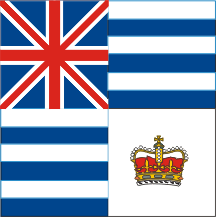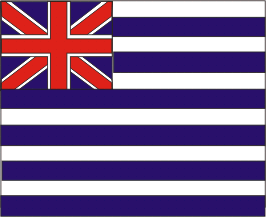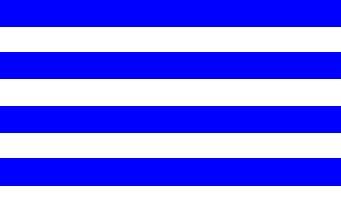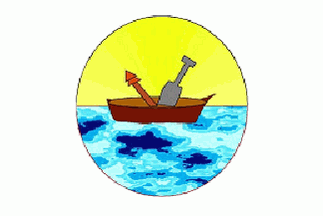![[Flag of Mosquito Coast (1834)]](../images/n/ni-mo183.gif)
image by Mark Sensen, 28 July 1996

Last modified: 2016-03-14 by zoltán horváth
Keywords: nicaragua | mosquito coast | mosquitia | moskitia |
Links: FOTW homepage |
search |
disclaimer and copyright |
write us |
mirrors
See also:
Other sites:
Željko asked: In the zone there existed another two British colonies, the Protected Kingdom of the Mosquitos (today Miskitos), and the colony of Bay Islands (today a Honduran province). Did there exist flags for the two territories?.
Both were given up before the 1864 Order-in-Council that
permitted colonies to have ensigns with flag badges - Mosquito
Coast in 1860 to Nicaragua and the Bay Islands in 1859 to
Honduras. I wasn't aware that the Mosquito Coast was constituted
as a kingdom within the British protectorate though, so it may
well have had a flag.
Roy Stilling, 26 July 1996
Here are the flags.
The first version was adopted 1834. The second was adopted
in 1860 when the Nicaraguan flag replaced the Union Jack in the
canton.
The 1986 Constitution provides for the autonomy of the two
Moskito Coast provinces. Source: William Crampton's
"The World of Flags".
Mark Sensen, 28 July 1996
This is one of a number of inconsistent British ensigns with
an 1801 Union canton that are shown in 19th century flag
books/sheets.
Blue and white stripes.
3b-3w : Mosquito Coast - Unidentified source 1824
5b-5w : ditto 1852 - Unidentified source
6b-6w : ditto 1853-81 - ditto
Mosquito Coast covered parts of modern Nicaragua and
Honduras. Possibly had some connection with Bay Islands a
dependency of Jamaica ceded to Republic of Honduras in 1859.
David Prothero, 30 January 2001
Below there are a couple of historical flags of the Mosquito
Coast, used in the 19th century. "Nations Without
States" describes a similar flag in use at present as the
national flag of the Moskitu people. It has 8 horizontal
stripes, alternately blue and white (I assume blue uppermost, but
it is not specified). The flags here appear to be based on 10
stripes. Also, the present one described in NWS has no charges or
other features beyond the 8 stripes.
Ned Smith, 24 March 2001
some time ago I searched in the miskitos flags. I read a
ponency in a national spanish Congress devoted to this topic.
Currently there's no flag for Miskitos, Sumos or Ramas, but
several parties that claim to represent this peoples has flags.
Neither RAAN neither RAAS (Autonomous regions of North and South
Atlantic) have official flags yet. Ex combatants for autonomy for
the Atlantic Coast readopted the 1824 flag that has 6 stripes and
union jack in canton. The Indigenous Movement Seven Tender Leaves
has a complicate flag which is very hard to describe: half
vertical blue (two shaddes) with several devices (a shil, a
lance, a sun, two birds)
Miskitos Asla Takanka Nicaragua has a flag of green, white and
yellow horizontal (1:2:1)
Indigenous Movement Rescue has a white flag with name of the
party in black, in spanish (upper) and miskito(?) (lower)
separate for the word MIRE also in black; at hoist is a blue palm
Autonomous party of the South region is blue over green with a
yellow sun in center near hoist
Multiethnic indigenous party has a flag of green, white and green
(1:2:1). Coastal Unity Movement (RAAN) is vertical green, white
and blue, and in center is a white bordered black bird above the
bird a semicircle of white bordered black stars (7 stars, two in
the green, two in the black and three in the white).
Yapty Tasba Masraka NanihTakanka: green with red circle lined
white and below white letters YATAMA. Whitin circle is lined
white a device: a boat above waves and crossed indigenous sword
and lance
The historic flag seems that was used in several patterns in the
years of the war against Sandinist. Flags with ten stripes
(5 blue and 5 white) as the flag of 1860-1993, with or without
canton (in the canton the nicaraguan natonal flag) was used, and
also with six stripes (in exchange the flag with 12 stripes
reported by Sternberg is not quoted any more)
About this flag (1860-1893) I'm unable to discover if the 1854-?
nicaraguan flag was used in this flag. I assume that, because the
flag with nicaraguayan flag in canton was created in 1860, the
1854 nicaraguayan flag was push into the flag, but I found only
versions in use later, when nicaraguayan de facto flag is already
the B-W-B.
Jaume Ollé, 26 March 2001
Mosquitia was self named Togosgalpa or Tologalpa during
spanish times. No spanish administrative body was present in
Mosquitia. The spanish ruler Philip V decree in 1707 on the
extermination of the Miskitos but this was never completed. The
local paramount chief put territory under british rule. The
British transfered the zone to Nicaragua 1894. In 1894 in
Bluefields era, the flag of Mosquitia was desecrated by
Nicaragua, and he was fired. Even if it was recognized in the
treaty where United Kingdom transfered the protectorate to
Nicaragua, really it was never used anymore.
The flag of Mosquitia was recognized de facto by Violeta Chamorra
when it was restored by the oldmen council on 17 Octuber 1996
(the oldmen claim to be the representative body of the
Communitary Miskito Nation) and was hoisted for 7 monthes but it
was forbidden by the rightist Arnaldo Aleman after he won the
elections. In 10 January Aleman anounced that the flag is
forbidden as separatist. Later he traveled to Mosquitia. The flag
was last hoisted on 4 May 1997, the day of the arrival of Aleman,
that ordered of its lowering from the Central Park of Puerto
Cabezas, the most representative place where it was hoisted.
During its short reaparence the flag was hoisted in Bilwi,
Waspám, Sisín, Kum, Francia Sirpi and la Esperanza. The flag
bear the british flag in canton, but, in front of the attacks of
Nicaraguayan, the oldmen council explained that this is their
historical flag and not a pro-british flag as assumed by european
originated people.
On 10 March 2002, under preasure of the miskito local leaders,
the oldmen council hoisted another time the Mosquito national
flag, exactly two month after Aleman finished his presidency
(Aleman was later presecuted as corrupter). On 20 June 2002, the
Moskito leaders anounced the full independence of the Communitary
Miskito Nation (I believe that they want a confederation with
Nicaragua or status of free asociated state)
Jaume Ollé, 23 June 2002
Jaume wrote that the local paramount chief put territory under
british rule. British transfered the zone to Nicaragua 1894.....
This would appear to have been a local agreement which was not
officially recognised. The only British colony in the area,
other than British Honduras (Belize) was Bay Islands off the
coast of Honduras. They were occupied by Britain in 1839,
annexed as a dependency of Jamaica in 1852 and ceded to the
Republic of Honduras in 1859.
I presume that the territory said to have been transferred to
Nicaragua was associated with Greytown (now known as San Juan del
Norte) where Britain maintained a consul ?
Mosquito Coast was, I think, another name for the Bay Islands,
which were occupied by Britain in 1839 and ceded to the Republic
of Honduras in 1859.
David Prothero, 23 June 2002 and 2 September 2003
The Mosquito Coast was in the same general area as the Bay
Islands, but they were not identical. The Mosquito Coast occupied
what is now the Caribbean coast line of Nicaragua. A map of it
can be seen at <www.zum.de>.
That site says a virtual British protectorate was established
there in 1848, but in this page, there are flags with Union Jack
cantons prior to that date, so there was probably some sort of
even more informal connection prior to 1848.
Since that site describes it as a "virtual"
protectorate it might be inferred that the relationship was never
formally ratified or recognized? In any case, whatever the
official nature of the relationship, Britain transferred its
protectorate (such as it was) to Nicaragua in 1860, which
formally annexed the Mosquito Coast in 1894, ending its status as
a distinct entity.
Ned Smith, 2 September 2003
Mosquito Coast was the name the eastern coast of Nicaragua had
(and still has) and that today is, I believe, a province with
some autonomy due to cultural specificities. The capital is named
Bluefields and it includes a group of islands in the Caribbean,
called "Cayos Miskitos".
Jorge Candeias, 2 September 2003
I read an article
on the BBC News website titled: "Nicaragua's Miskitos seek
independence.
What is more, the flag of "independent Mosquitia"
described in the text at <www.laprensa.com.ni>
does not really ring a bell either:
"La bandera que de ahora en adelante debe, según el Consejo
de Ancianos, prevalecer en La Mosquitia es verde y con un indio
en medio, un sol y luna a los lados, además de dos
estrellas." (The flag that should from now on prevail in
Mosquitia, according to the Council of Elders, is green with an
Indian at the centre, a sun and a moon on the sides, in addition
to two stars).
Oddly enough, <www.puebloindio.org>
does discuss the flag but does not show any picture.
Le Thanh-Tam, 3 August 2009
While looking for more information on the Miskito flag, I came
across this unusual
UJ-ensign styled flag at <www.geocities.com>.
It appears to be the same as the royal standard,
but in rectangular format.
James Dignan, 4 August 2009
The newspaper article on the BBC News refers to the city of Puerto Cabezas called "Bilwi"
in Miskito (Moskitia language). Puerto Cabezas is
located in the Región Autónoma del
Atlántico Norte in the territory known as Mosquitia (spelled
also Moskitia), which is actually the Costa de Mosquitos
(Mosquito Coast).
The newspaper article refers to the local form of natives
people's government, called the Communitarian Nation of Moskitia
(see wikipedia):
"The Wihta Tara, Grand Judge, Héctor Williams, together
with the Advisor to the Council of Elders, Oscar Hodgson, visited
Bluefields and Rama Cay to gather with several local sectors
seeking their support for the Declaration of Independence of the
territory of La Mosquitia from Nicaragua".
This separatist remarks were first endorsed and stimulated, as
the newspaper article states, by the Fsln guerrilla prior to their
taking of power in 1979 as a way to seek the support for its
leader Daniel Ortega, to organize the indigenous communities
under the leadership of a Fsln cadre (Steadman Fagoth), but once
the indigenous people backed away from this offer, the Fsln
retired from their deal.
E.R., 4 August 2009
The questions about the crosses being joined in the royal standard of Moskitia, reported correctly by
Jaume Ollé, is answered definitively by the photograph of it taken in the
Central Park in Bilwi (PuertoCabezas) in 1997 seen at
<members.cox.net>.
The Miskitos consider it their traditional flag and were outraged
by the order of ex-president Alemán to take it down during his
visit to Bilwi on May 4, 1997 (as described by Jaume).
The flag appears to be rectangular.
Jaume mentions also other flags used by the Miskitos,
but this is very poorly documented on the internet, if at all.
The flag of the political
party YATAMA, described by Jaume, can be seen at: <upsidedownworld.org>
with the detailed info on the organization and in another photo at: <www.grupoese.com.ni>.
The central charge of that flag is identical to the emblem of the
Communitarian Nation of Moskitia as seen at: <www.puebloindio.org>,
but not in colors (note that .site is outdated and not kept up to
date, so the emblem might be obsolete).
The report of the flag of the Communitarian Nation of Moskitia,
describes the flag, supposedly adopted after the declaration of
independence by the "Almuk nuni" (Elders Council) on
April 18, 2009 (really re-declared, as the original declaration
of independence was issued in 2002 already). This flag is
described as: "The flag that from now on must, according to
the Council of Elders, prevail in the Mosquitia is green and with
an Indian in the middle, a sun and moon on the sides, in addition
to two stars".
There is no image of this flag made available on the net yet. The
Indian mentioned in that report might be looking like that.
For comprehensive history see: <www.answers.com>.
Chrystian Kretowicz, 6 August 2009
On www.bbc.co.uk>,
the first seconds of the video report shows Miskitos displaying
the flag of the
Communitarian Nation of the Moskitia. It is in fact green but
with in the center a big white rectangle on which you can see:
- the moon and stars (much more than two. I see at least 8 stars,
including if I am not wrong Ursa Major) on the left side on a
greenish sky,
- a circular seal in the center, probably with an Indian in the
middle (hard to say what he looks like exactly, if it is a face
as on the link reported above, if it has somehting to do with the
Elders council
symbol seen at or if it is a different drawing).
- an orange little sun on the right side.
The whole flag cannot be seen but on can think the green border
occupies the 4 sides of the flag, hence the description as a
"green" flag.
Olivier Touzeau, 23 August 2009
![[Flag of Mosquito Coast (1834)]](../images/n/ni-mo183.gif)
image by Mark Sensen, 28 July 1996
![[Flag of Mosquito Coast (1860)]](../images/n/ni-mo186.gif)
image by Mark Sensen, 28 July 1996
![[Flag of Mosquito Coast (1860)]](../images/n/ni-mc1870.gif)
image by Fred Drews, 05 September 2014
![[Flag of Mosquito Coast (1860)]](../images/n/ni)mc1870.gif)
image by Fred Drews, 05 September 2014
I found the coat of arms of the Mosquito Coast from 1860 in the Government of
the Nación Comunitaria Moskitia, which they still use as their current coat of
arms and also found two different flags although very similar that they use and
the seal of the council of elders.
Fred Drews, 05 September 2014

image by Jaume Ollé, 17 June 2002
The flag above for 1834 is not quite correct. The last
quarter, bottom right, should be plain white with a crown in the
centre as in the image.
The source is "Mosquito, Nicaragua and Costa Rica".
Second Edition. Effingham Wilson, Royal Exchange, London, 1849.
The standard appears in colour on the title page. Unfortunately
the author is anonymous.
Christopher Buyers, 16 June 2002
What is the source for this image? And it would be more
convincing if it didn't have the common error of joining up the
two red crosses of the UJ.
André Coutanche, 17 June 2002
This standard was designed by the British consul Patrick
Walker to be used in the coronation of the king George in 1845.
Sources: Mc Meekin, Flags of Mosquitia, Poyais and
Araucania FB XVIII:2 (image page 53, text related pages 52
to 65) that quote the source for this flag: "Mosquito,
Nicaragua and Costa Rica" (image in the cover) and undated
and anonymous book a copy of which is in the British Library,
published in London about 1850.
Jaume Ollé, 17 June 2002
Jaume's message has sources, but it remains, IMHO, dubious for
the reason I cited in response to the first message: the UJ has
its red crosses meeting. I simply do not believe that (in this
form, at least) it "was designed by the British
consul".
André Coutanche, 17 June 2002
It is strange undeed, but all the construction is strange.
British consul in this remote zone was not a heralidst or
vexilologist, and perhaps he found too difficult to made the UJ
as had to be (specially in square form) and simplified the
design. Notice that even in W. Smith FTTAW the UJ is slighty
wrong. Or perhaps this image is taken from the published one in
1850 that was not absolutely in agreement with the real one.
Jaume Ollé, 17 June 2002

image by Jaume Ollé, 18 May 2003
No. 602 - King of the Mosquito Coast (1852).
Source: [stb62] .
Jaume Ollé, 18 May 2003

Flag of the National Movement
image by Chrystian Kretowicz, 6 August 2009

The flag of Almuk Nani
image by Chrystian Kretowicz, 6 August 2009
I'm presenting to you two flags reported by James B.Minahan in
his books: 'Nations Without States' and 'Encyclopedia of the
Stateless Nations': "The Miskito national flag, the flag of
the national movement, has eight horizontal stripes of blue and
white. The flag of Almuk Nani (the Elders Council) is considered
the traditional flag of the Miskitos, a white field bearing a
centered disc bearing a blue sea, a spear and a shovel in classic
brown Miskito canoe, and a yellow sky". (There are reports
of the first flag having 6, 10 or 12 stripes also)
Chrystian Kretowicz, 6 August 2009
![[Flag of Mosquito Coast (1860)]](../images/n/ni-mcm-a.gif)
image by Fred Drews, 05 September 2014
Flag Nación Comunitaria Moskitia.
Fred Drews, 05 September 2014
![[Flag of Mosquito Coast (1860)]](../images/n/ni-mcm-b.gif)
image by Fred Drews, 05 September 2014
Flag of
Nación Comunitaria Moskitia with Coat of arms of the Consejo de ancianos de la Nación Comunitaria Moskitia (government
version)
Fred Drews, 05 September 2014